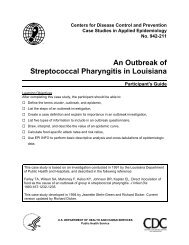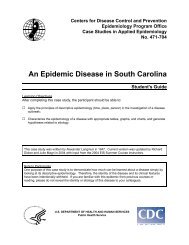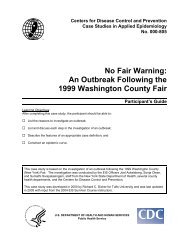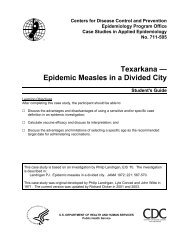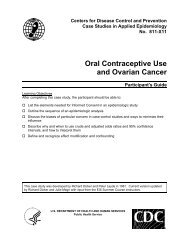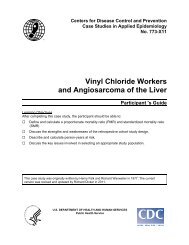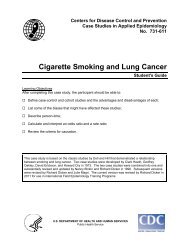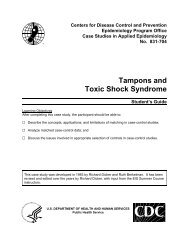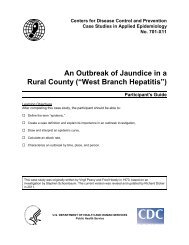Hepatitis E outbreak due to contaminated tamarind water ... - Library
Hepatitis E outbreak due to contaminated tamarind water ... - Library
Hepatitis E outbreak due to contaminated tamarind water ... - Library
- No tags were found...
You also want an ePaper? Increase the reach of your titles
YUMPU automatically turns print PDFs into web optimized ePapers that Google loves.
<strong>Hepatitis</strong> <strong>outbreak</strong> in a schoolBaripada,Orissa,EasternIndia,2010• 14 September 2010– Private practitioner reported treating a clusterof school students suffering from jaundice– Parents complained about school authorities• 15 September 2010– Started <strong>outbreak</strong> investigation• Objectives– Identify the agent and source– Propose control measures
Incidence of hepatitis by week of onset,Baripada,Orissa,EasternIndia,20102520Number of cases151050week1week2week3week4week5week6week7week8week9week10week11week12week13Week of onset
Spot map of hepatitis cases,Baripada,Orissa,EasternIndia,2010
Incidence of hepatitis by age and gender,Baripada,Orissa,EasternIndia,2010Characteristics # Cases Population Attack rate per 100Age < 5 1 120 0.85 – 10 28 620 4.511 – 15 76 515 14.816 – 18 6 65 9.2> 18 8 20 40Gender Male 76 724 5.7Female 43 616 3.2Over all 119 1340 8.9
Environmental investigations, <strong>Hepatitis</strong><strong>outbreak</strong>, Baripada,Orissa,EasternIndia,20101234
Generation and testing of hypothesis,hepatitis <strong>outbreak</strong>,Baripada,Orissa,EasternIndia,2010• Hypothesis generation from descriptiveepidemiology– All cases from school (students / staff)– Clustering of cases around the school– Mobile food kiosks probable source• Three of seven serum samples testedpositive for HEV• Case control study– 119 cases and 119 controls
Frequency of exposure (%) among<strong>Hepatitis</strong> E cases and controls,Baripada,Orissa,EasternIndia,2010Cases(n=119)Controls(n=119)Ate “Gupchup” 81 33Did not eat “Gupchup” 19 67Odds ratio(95% CI)8.6(4.5 -16.3)Population attributable fraction -96%
Limitations• Information bias– Self reporting regarding the consumption ofgupchup from the mobile food kiosk
Conclusions• An <strong>outbreak</strong> of hepatitis E affected theschool in Baripada• May have been caused by consumption of<strong>contaminated</strong> <strong>tamarind</strong> <strong>water</strong>
Recommendations• Short term– Close food kiosks near all schools– Chlorinate <strong>water</strong> sources in the municipality– Educate school students, teachers, foodvendors• Long term– Train food vendors on food hygiene– Supervise kiosks by sanitary inspec<strong>to</strong>rs
Acknowledgements1. Ms. S. Aswasthy, IAS, District Magistrate, Mayurbhanj, Orissa foradministrative support2. Dr. C. Murmu, Chief District Medical Officer, Mayurbhanj, Orissa3. Dr. R. D. Brahma, Asst. District Medical Officer (Public Health),Mayurbhanj, Orissa4. Dr. S. K. Kar, Direc<strong>to</strong>r, Regional Medical Research Center,Bhubaneswar, Orissa for labora<strong>to</strong>ry support5. Dr. J.R. Mandal, Pathologist, Regional Diagnostic Centre,Mayurbhanj, Orissa6. Members of the District Task Force Team, Mayurbhanj, Orissa7. Dr. Mrs. B. Murmu, Health Officer, Baripada Municipality8. All the health service providers who helped in conducting thesurvey9. TEPHINET for funding <strong>to</strong> attend the conference and present thescientific paper
Thank you



